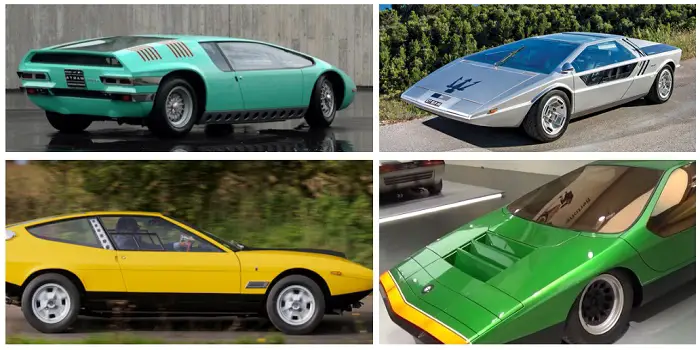Wedge-shaped automobiles are among the most brilliant automobile designs ever created that came out of Italy in the late 1960s and early 1970s.
Show cars like the Ferrari 512S Modulo and the Bizzarini Manta design took the auto industry by storm and set a new style trend that spanned more than two decades.
Here you’re going to find the 10 best Lancia concept cars of all time.

Table of Contents
1. Lancia Stratos Zero
The Lamborghini Marzal, Alfa Romeo Carabo, Bizzarinni Manta, and the extreme Ferrari Modulo were all products of the ‘Wedge Wars’ of the 1970s.
When it debuted at the 1970 Geneva Motor Show, the latter, at only 93.5cm height, may have looked to be the pinnacle of the design trend.
That was until the following year’s Turin Motor Show when the 84cm tall Zero made its debut.
The Zero was the creation of Marcello Gandini and was the apex of automotive design.
The headlights were made up of ten small bulbs, while the tail was lit up by 84 lamps around its circumference.
Occupants entered through a flip-up windscreen, with the green Perspex instrument panel tilted to one side and the minimum side windows retracting into the rear bodywork.
According to insiders, when Bertone took the automobile to the Lancia plant to display it to the board of directors, he just drove under the access barrier.
2. Maserati Boomerang
Of course, Maserati has to be included on this list.
The Boomerang arrived late to the wedge concept party, but it was futuristic enough to stand out at the 1971 Turin Motor Show.
It debuted in Italy as a non-functional model, but the firm was able to install a 4.7-liter V8 engine beneath the seats in time for the 1972 Geneva Motor Show.
Maserati had already used many of Boomerang’s design elements for the mass-produced Bora by that point.
The Boomerang is said to have inspired several of Giugiaro’s production car designs during the 1970s, including the Lotus Esprit, first-generation Volkswagen Passat and Golf, and third-generation Maserati Quattroporte.
3. Lancia Medusa
Following multiple oil shocks at the end of the 1970s, car designers shifted their focus to showing their aerodynamic abilities rather than creating outrageous wedges.
While developing as one of the world’s most aerodynamic cars it started with the Lancia Monte Carlo, whose mid-engined arrangement allowed for an extremely low and smooth bonnet line for a four-door saloon.
Those doors were not gullwing, as their design implies, but were wrapped into the roof for a cleaner appearance.
Italdesign’s goals were met, thanks to streamlined door handles a single, compact side mirror, and small side window apertures.
4. Bizzarrini Manta
The Manta, which was also unveiled in 1968, was Giorgetto Giugiaro’s first car created for his then-new business, Ital Design.
It is based on the Bizzarrini P538 racing vehicle and is distinguished by the continuous curve that extends from the nose to the rear.
The Manta is credited with pioneering the one-box automobile design for this characteristic.
The Maserati Bora and Merak of the early 1970s were undoubtedly influenced by the Manta’s angular aesthetic elements and unique features, such as retractable shades behind the windscreen.
The odd-looking Bizzarrini is especially notable for its three-seat cockpit, with the driver’s seat in the center.
After multiple ownership changes, the Manta was restored to its original specs in the early 2000s, receiving a prize at the 2005 Pebble Beach Concours d’Elegance.
5. Lancia Fulvia HF Competizione
According to sources, Tom Tjaarda designed it at the request of Alejandro De Tomaso in the late 1960s as a honey trap to attract Ford to purchase Lancia.
De Tomaso hoped that by portraying Lancia as a possible Ferrari rival, Ford CEO Lee Iacocca would buy the firm and put him as CEO. Even though history says otherwise, Tjaarda referred to the automobile as one of his favorites when he has reunited with it a few years ago.
The Competizione, which was built on a Fulvia chassis, concentrated on lightweight and aerodynamics to build a car with GT credentials that could also handle a circuit.
The V4 engine of the Fulvia was situated 30mm lower for a sleeker bonnet line with retractable headlamps, and the rear wing was deployable and adjustable by the driver.
An internal roll cage, rear wishbones in place of the solid axle, an aluminum fuel tank, and even thinner windshield glass to the point that it was subsequently considered as a potential Le Man’s entrant.
6. Alfa Romeo Carabo
The Alfa Romeo Carabo, designed by Marcello Gandini while working at Bertone, was one of the earliest wedge-shaped concept automobiles ever constructed.
Based on the chassis of the notorious Alfa Romeo 33 Stradale, the Carabo triumphed the whole crowd at the 1968 Paris Motor Show with its strong angular lines, flat profile, and shimmering green and orange paintwork.
The Carabo was a completely functioning car that borrows all of the underpinnings from the Alfa Romeo 33, including the mid-mounted, 2.0-liter V8 engine with 230 horsepower.
7. Lancia Gamma
Taking a saloon and turning it into a coupe is standard procedure, and that’s exactly what Lancia did with the 1978 Gamma.
The first was a Gamma Spider with a Targa top that matched its sharply sloping C-pillar.
The Gamma of 1980 stretched the two-door design and added a pair of rear doors for a result that was certainly more attractive.
8. Ferrari 512S Modulo
The Ferrari 512S Modulo, arguably the most original concept car on our list, made its debut at the 1970 Geneva Motor Show.
The Modulo, designed by Paolo Martin at Pininfarina, had a remarkably flat body, even when compared to earlier wedge-shaped designs, with a canopy-style glass roof.
Modulo’s UFO-like look was aided by partially covered wheels and 24 holes in the engine cowl.
The Modulo maintained the race car’s engine, a 5.0-liter V12 with 550 horsepower, but the drivetrain was later removed to allow the coachbuilder to complete the project.
Due to delays, the design was introduced without the V12 in Geneva. At the time, Ferrari claimed that the Modulo could reach a peak speed of 220 mph.
The one-of-a-kind show car was sold to James Glickenhaus in 2014, and he refurbished it in time for the 2018 Concorso d’Eleganza Villa d’Este.
9. Lancia Flaminia Loraymo
Yes, beauty is in the eye of the beholder, and there are undeniably appealing components of the Loraymo, but the overall effect, particularly at the front, is one of goofiness rather than gorgeousness.
So, why is it on our list? Because of its author, the famed American industrial designer Raymond Loewy.
Loewy was well-known for his ideas for everything from the TWA emblem to the Greyhound bus. Loewy not only developed the logo for Studebaker but also designed the iconic Starliner and Starlight coupes.
The Loraymo, based on the Lancia Flaminia Coupe, expanded that motif with an enlarged nose whose chrome frame doubles as a bumper, foglights set on aerodynamic fins, a wraparound back screen with a roof-mounted spoiler above it, and flush taillights.
Loewy was delighted enough with the outcome to exhibit it at the 1960 Paris Motor Show and give it a namesake composed of letters from his name.
10. Nardi Raggio Azzurro I
This commission from former Lancia engineer and racing driver Enrico Nardi, albeit a couple of years before the launch of Sputnik, marked the transition from the jet age to the space race.
The alloy panels were supported by a Nardi-designed tubular steel frame, while the Aurelias’ V6 received a considerable power boost thanks to Mardi camshaft, pistons, manifolds, and intake.
The sweeping, two-tone exterior, with its grille-mounted headlamps, is eye-catching on its own, but the blue Perspex canopy atop takes it to new heights.
The canopy contained side windows that extended upwards towards the center of the roof, as well as an incorporated fresh-air scoop.
Conclusion
All of the concept cars mentioned above had an impact on automotive design during the next two decades.
The Lamborghini Countach, De Tomaso Pantera, BMW M1, Maserati Khamsin and Ferrari 308 GT4 are all wedge-shaped models.
This tendency continued far into the 1980s, when most automakers were still producing wedge-shaped (but boxier) vehicles.
Among the notable examples from this era are the DeLorean DMC 12, Ferrari F40, and Subaru XT, to mention a few.
It’s a trend that may not return anytime soon, but the Tesla Cybertruck serves as a reminder of the golden age of crisp aesthetic cues and a plethora of horizontal lines.

Based in Orem (Utah) John Paterson graduated from Utah Valley University and has begun writing in 2009. He has a large wealth of experience in writing articles related to cars, automotive repair, wheels, cleaning/maintenance, and much more. He has also written instructional articles in a similar niche for a few online publications as well. Currently, he works as a mechanic in his personal garage shop where he loves serving his countrymen from his heart.




